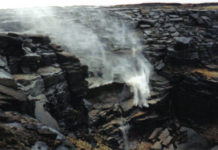The existence of a paradise on Earth where all was perfection has been part of human belief from earliest times. Its location may never be known, but the Garden of Eden has been a most fruitful source of artistic inspiration. The account in the book of Genesis of the creation of Adam and Eve, their fall from grace and expulsion from the paradise on Earth that God made for them, lies at the heart of the Jewish and Christian traditions. Throughout the centuries, the idea of the Garden of Eden has captured the creative imagination of generations of artists and writers.
The world’s most famous garden was idyllic, well-watered and abundant with food. For company, Adam and Eve had ‘every beast of the field and fowl of the air’. Trees provided ample shade; a sparkling river flowed through the garden and, once outside, divided into four streams – the Pishon, Gihon, Tigris and Euphrates. That much was documented. Shape, size and location were left open to interpretation. The only tree whose presence can be inferred with any degree of certainty is the fig, although later tradition identified the date palm with the tree of life and the banana plant as the tree of knowledge of good and evil.
The garden was usually conceived of as enclosed, although this may be because the word paradeisos, the Greek translation of Garden of Eden, means ‘an enclosed piece of land’. From these scant beginnings, poets and painters, commentators and theologians fashioned images of Eden, often drawing on other traditions of the earthly paradise to round out their own interpretations.
Jan Bruegel followed an artistic tradition stretching back centuries when he painted his vision of a lush paradise in 1620. He had some advantages over earlier artists in that he was able to include exotic birds such as parrots, which he could paint from life, or at least from illustrations by those who had seen such creatures in the flesh. In addition, his animals, while not necessarily native to Europe, did not have to be conjured from fantasy. He chose to take the story of the apple literally, incorporating an abundant crop.
The lack of any detailed description of the garden has given artists free rein over the centuries. The Dutch painter Hieronymous Bosch (1450-1516) envisaged a rural idyll, where Adam and Eve lived in harmony with exotic animals and birds. Bosch’s well-watered Garden of Eden supported an abundant and luxuriant plant life.
Probably the oldest account of such a paradise dates from the early third millennium BC. The Sumerian Dilmun, situated where the sun rises, was the abode of the gods, a place where grieving, sickness and old age were unknown and where ‘the raven’s croak could not be heard’. There is more specific reference to a magical garden (albeit bearing more resemblance to ‘God’s garden’ of the book of Ezekiel than to the Eden of Genesis) in the Sumerian Epic of Gilgamesh (2000 BC). Here, the hero Gilgamesh journeyed to a mountaintop ‘garden of the gods’, where the bushes glittered with gems: fruits of carnelian and leaves of lapis lazuli.
The non-Biblical descriptions of paradise that had most influence on later Christian visions were those of the Classical poets. Sometime around the eighth century BC, the Greek epic poet Homer wrote of a place he called Elysium, situated at the world’s end. There was no snow in Elysium, nor any strong winds, just a gentle refreshing breeze. Homer’s contemporary Hesiod, by contrast, focused on idyllic existence, rather than the place itself, evoking a lost golden age when people were at peace. Like Adam and Eve before the Fall, they never grew old, but lived, free from toil, on the ample bounty of the fruits of the land.
Homer and Hesiod, and the later Roman poets Virgil and Ovid influenced visions of the garden from the early Christian era to the Renaissance and beyond. In his epic work Paradise Lost, English poet John Milton (1608-74), for example, described the Garden of Eden in vivid detail. His paradise was a walled plateau on a craggy, wooded mountain, reached by climbing a steep path. Scented plants such as myrtle and balm perfumed the air, which was filled with birdsong; trees provided shade, and streams and fountains offered an ample water supply. Milton’s Biblical sources and weave it into a coherent whole. The perpetual spring that the garden enjoyed and its fertile soil were both firmly rooted in Classical Elysium.
The garden as a feast for the sense is also a feature of the Islamic paradise which, unlike the Garden of Eden, exists in heaven rather than on earth. According to the Koran, steadfast Muslims will be rewarded in the afterlife with gardens containing gushing fountains and flowing springs, shade-giving trees (including the palm and the pomegranate) and soft couches on which to lie. Dressed in green silk robes, the blessed, attended by virgins ‘as fair as rubies and corals’, will be served food in silver dishes.
While the Islamic world was more concerned with re-creating paradise on Earth by building idyllic gardens, their Christian counterparts, as late as the Middle Ages, became obsessed with the idea of finding the Garden of Eden. Some believed it must have been destroyed in the Great Flood; others that the garden was cited on a mountain and so survived. A popular view formed that it was located in the east, on an island, and Sri Lanka became the preferred site. When Christopher Columbus deduced that the world was not flat but pear-shaped, this prompted the conclusion that the Garden of Eden was situated on its ‘stalk’.
Islamic gardens, whether in Iran, India, Moorish Spain or elsewhere, have in common pools of water blue with the reflection of the sky, playing fountains, scented flowers and shade-giving trees, in accordance with the Koranic description of paradise. The garden at Fin in Iran was created in the 16th century and, following tradition, is enclosed, rectangular and divided into four quarters by water channels that mirror the four rivers of life.
As more and more of the world was charted, but still with no sign of the garden, scholars returned to Genesis looking for clues as to its whereabouts. Mesopotamia (an ancient region that includes present-day Iraq) seemed the obvious place to start since the Tigris and the Euphrates, named in the Bible, flow through the area.
Mesopotamia, however, is huge, and the other two streams, the Pishon and the Gihon, could not be located and so were of no help in pinpointing the site of the garden. Jerusalem, and Golgotha, where Jesus was crucified, were also associated with the garden. Since Jesus was often typified as the second Adam, it was satisfying to link the place of His death with the site of Adam’s banishment.
Traditionally, the botanical garden was conceived as an attempt to re-create the Garden of Eden by bringing together flowers, shrubs and herbs from all over the world. The University of Oxford Botanic Garden in England was laid out in 1621 in four quadrants to symbolize the four rivers of life and the four known continents – Europe, Africa, Asia, and America.
It is thought that the inability to locate the Garden of Eden prompted Christians to follow the Islamic lead and try to re-create it. For inspiration, they looked to the Bible and Classicism rather than the Koran; nevertheless, in the botanic gardens of Padua, Paris, Oxford and elsewhere laid out in the 16th and 17th centuries, they succeeded in fashioning paradise on earth.
-end-




































